
gewächshaus
für
zeitgenössische kunst
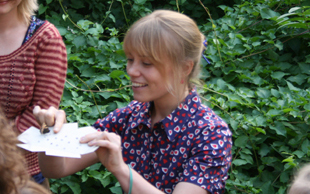
Louise
Schrader (DK)
Butterfly Viborg/Berlin, performance, 2007
Dead Pan Exchange II | 13.06.2007
Organised by Heidi Hove Pedersen, Jonn Herschend and David Keating
Artists: Søren Assenholt (DK), Jens Axel Beck (DK), Marianne Bitsch & Brian Enevoldsen (DK), Ina Viola Blasius (DE) & Stine Marie Jacobsen (DK), Jacob Borges (DK), Matthew Hughes Boyko (US), Jesper Carlsen (DK), Melissa Day (US), Morten Dysgaard (DK), Morten Espersen (DK), Patricia Esquivias (ES), Rosa Marie Frang (DK), Gudrun Hasle (DK), Kara Hearn (US), Cecilia De Jong (DK), Kari Mette Josefsen (DK), Morten Kaer (DK), Dagmar Krøyer (DK), Lasse Ernlund Lorentzen (DK), Kristin Lucas (US), Marie Kolding Lund (DK), Mads Lynnerup (DK), Line Sandvad Mengers (DK), Tine Oksbjerg (DK), Susan O'Malley (US), Karen Petersen (DK), Daniel Rees (DE), Will Rogan (US), Louise Schrader (DK), Tina Scherzberg (DK), Kirstine Strømberg (DK), Tim Sullivan (US), Anne Walsh (US), and Lindsey White (US).
Deadpan Exchange II
The one night festival Deadpan Exchange II, was conceived as an exploration of the deadpan aesthetic. Consisting of performances, site-specific installations and video screenings from Denmark, Spain, Germany and the United States.
The Deadpan aesthetic usually requires a straight-faced delivery of information. In most cases the information being delivered boarders on the questionable to the completely absurd, but the deliverer of the information must maintain a dead serious composure. There is a beauty to the humanity in this because the information involved has elements of both comedy and tragedy and the viewer has to decide which way to go. Because of this, the viewer becomes a collaborator and automatically an interpreter of the piece.
The organizers of this exhibition and screening feel that we are at a black and white point in history, a place where individuals are no longer asked to process the world around them. Instead they can simply download an opinion or a point of view. The reality of the situation is that life is a messy endeavor that requires a constant need for interpretation and examination. The deadpan aesthetic takes the viewer to the grey area between the black and white facts and directly into the messiness of interpretation. Through humor, absurdity and tragedy, this aesthetic asks the viewer to interpret and thereby acknowledge the existence of the work they are viewing as well as their own existence.
The uses of deadpan fully entered the contemporary art world in the late 1960's and 70's, when many artists rejected the aesthetic of the modern art world in favor of a more stripped down interaction with the viewer. Many of these artists—Bas Jan Adar, Martha Rossler, Vito Acconci, Marina Abramovich, Gordon Matta Clark, Chris Burden, to name a few—sought a stripped down form of interaction with their environment and the viewer. The notion of deadpan worked perfectly with much of their documentation and presentation. It was a rejection of high art in favor of a more flat footed or ham fisted amateur presentation. In many cases the viewer had to ask, "is this for real" because the presenter (think Martha Rosler and her "semiotics of the kitchen") was dead serious even in situations that seemed completely absurd. This serious absurdity pared with the extreme convictions of some of the actions, such as Bas Jan Ader's "Fall 2," a video in which the artist rolls off of the roof of a house, created a tension and opened the door for crisis, both in the mind of the viewer and in the action that was being portrayed.
www.koh-i-noor.org
www.deadpanexchange.com
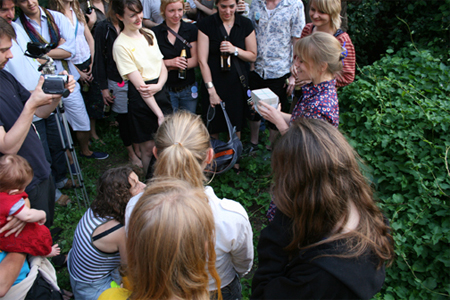
Louise
Schrader (DK)
Butterfly Viborg/Berlin, performance, 2007
I will transport a butterfly from Viborg (DK) to Berlin (DE). At the exhibition
the jar will stand on the ground and people will be able to pick it up
and observe the butterfly. As a performance, I will open the container
and the butterfly will be able to fly out into Germany.
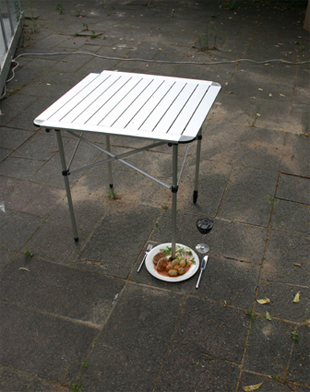
Por-table, performance, 2007
I’m going to bring a portable table with me to Berlin. My big ego demands that I try to create my own space or frame it in a context of many people. In Berlin the table is going to be that space.
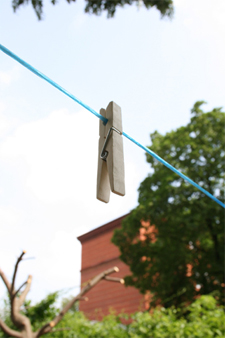
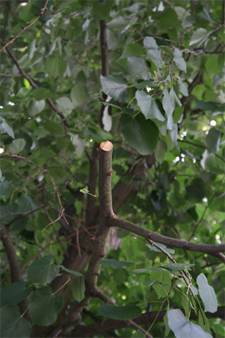
Clothes-peg made of wood from the tree at Schwedterstrasse 232 – 234 whittled and carved by hand hung on a clothes-line, sculpture, 2007
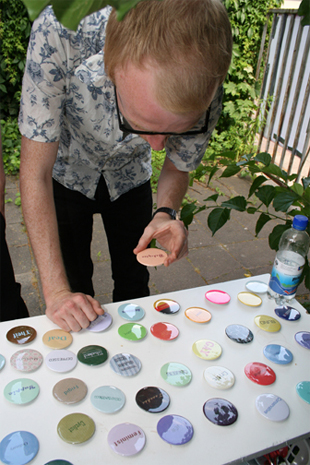
Line
Sandvad Mengers (DK)
Did you hear the one about the artist, the Christian and the smoker? 2007
This is a project that provides badges with subjects appropriate for you
to draw on, when using deadpan humour. An inaccurate use of deadpan humour
makes it easy to be misunderstood. Therefore, to prevent you from insulting
others unintentionally, you are encouraged to look at yourself for material.
the audience are offered to select three, from a variety of badges, with
the purpose of illustrating that you, due to personal reasons, might be
joking with the selected subjects.
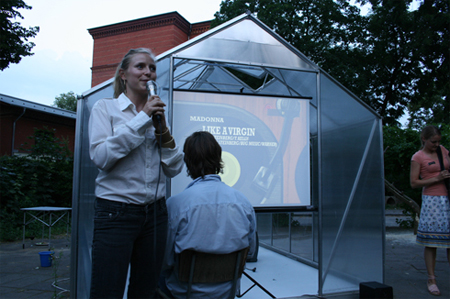
Dyslexia Karaoke, 2007
As a dyslexic it feels like being inside and outside at the same time. You need to take detours to reach same knowledge as everybody else. It is a way of being different as other minorities such disabled, homosexuals, and even just as women. Dyslexia karaoke is a performance. I perform with my boyfriend in order to show my dependence of my family. My boyfriend reads the text aloud from the karaoke monitor while I try to sing as fast as possible in order to follow the song and the rhythm. Well knowing that the error repeats itself.
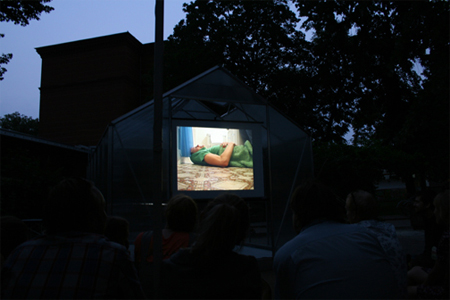
ET, (from 14 Scenes Reincarnated) digital video, TRT 28:50, 2005-2006
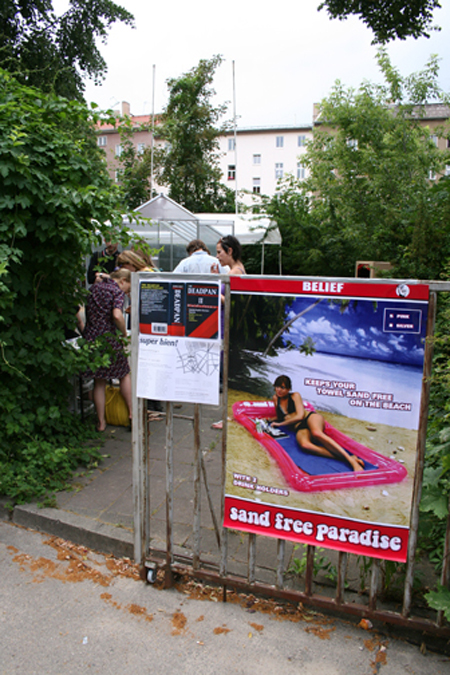
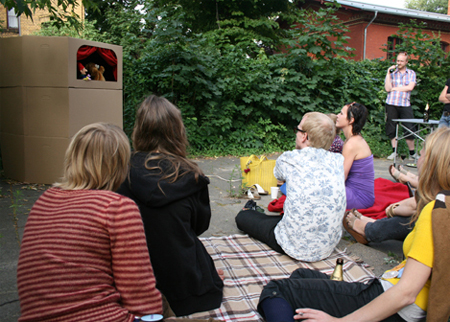
The telling of an artpiece I only heard about I am doing a re-make of an art piece, which I've never seen, but only heard about through other peoples telling. In coherence to art, there are many rumors and stories, which are connected to a social gathering. Such stories and rumors give you status in a social, art context, both the fact of having been there, being able to entertain and posses a knowledge not everyone has. It is presented as a puppet show, which posses the history of going from market to market entertaining with stories, spreading the word of what happened - and having a slightly moralistic, educational and satirical tone. The piece is about the character of the piece/the happening and how this is being set into a social connection.
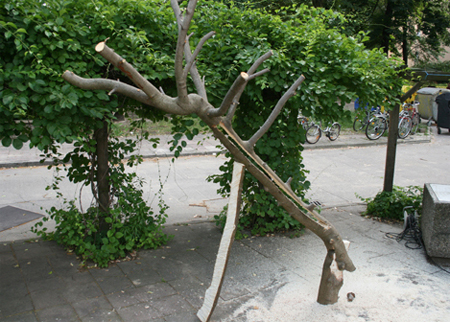
As part of an ongoing investigation of bio-mass and manual labor Assenholt will cutting a hinge into a tree and removing a piece of wood make the tree support itself.